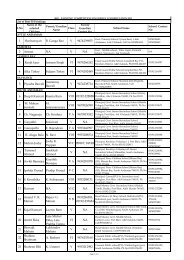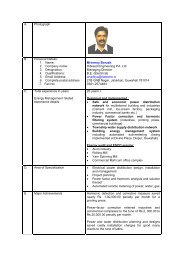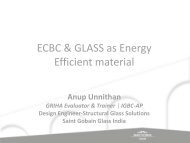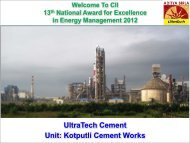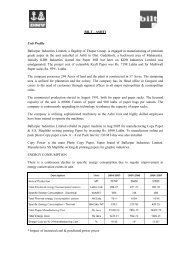Buildings Envelope
Buildings Envelope
Buildings Envelope
Create successful ePaper yourself
Turn your PDF publications into a flip-book with our unique Google optimized e-Paper software.
Energy Efficient<br />
- <strong>Buildings</strong> <strong>Envelope</strong><br />
- From the ECBC Perspective<br />
ECBC Awareness Workshop<br />
Saint-Gobain Glass India Ltd
ECBC - Building <strong>Envelope</strong><br />
Opaque Wall & Spandrels: Insulation materials<br />
and their R-values / U Value;<br />
Vision Glass or fenestration / glazing:<br />
U-factors,<br />
Solar heat gain coefficients (SHGC) or SF<br />
Visible light transmittance<br />
Shading: overhangs and side fins,<br />
Air leakage though facade<br />
Building envelope sealing details
Glass gives beauty & modernity to architecture:<br />
- Architectural master pieces<br />
- Modernity - Transparency<br />
Advantages of using Glass & glazing systems:<br />
1. Faster is construction<br />
2. Thinner structure - increase floor area<br />
3. Advance systems<br />
Predictable behavior in case of<br />
earth quark and building settlement<br />
Water tight<br />
4. Glass is lighter by 12 times than brick wall<br />
i.e. 1000sqm of glass of reduces<br />
load of building by 500 tons
Glass is transparent thus:<br />
- Daylight for interiors<br />
- Blends Interiors with Exteriors<br />
Nokia, Gurgaon<br />
Infosys, Mysore<br />
Hyatt Regency, Mumbai Town Hall London<br />
But, it is important to:<br />
1. Control Light – Based on direction<br />
of façade – Minimize Glare<br />
2. Control Energy – Based on the<br />
direction & location – Minimize<br />
Heat Gain
Key Performance Factors<br />
Total Heat Gain / Heat Transmission<br />
SHGC or SF : Solar Heat Gain Coefficient or<br />
Solar Factor<br />
U Value<br />
Light Transmission: percentage of incident<br />
light transmitted
Day Lighting:<br />
Control Light –<br />
Based on direction of façade –<br />
Minimize Glare
Light Transmission (LT):<br />
How low can the LT of the glass be ?<br />
Sun light: 90,000<br />
to 113000 Lux<br />
Effect of Sun: Day Light<br />
Light required for<br />
working = 500 Lux<br />
Light Transmitted<br />
Thus…..<br />
Light transmission needs to be optimised to reduce<br />
GLARE and enhance occupant COMFORT<br />
Shade :<br />
9,000Lux
Simple Modification - Reflectors<br />
Avoids excessive glare, increased depth of natural<br />
day lighting and acting as shade to vision area<br />
2.5 H<br />
H
Automated Louvers<br />
Modern Mechanism: Effective Day Light<br />
Light Selves<br />
Ceramic Fritting<br />
Shading Device: Horizontal or<br />
vertical
Total Heat Gain / Heat<br />
Transferred
UV Visible<br />
.25<br />
Electromagnetic Spectrum at Terrestrial Level<br />
Heat Gain due to<br />
direct solar radiation<br />
TOTAL HEAT GAIN<br />
Near Infra Red<br />
Total Heat Gain<br />
Amount of heat<br />
Transferred due to<br />
temperature difference<br />
Far Infra Red<br />
.38 .78 2.50<br />
50 µ<br />
Wave Length
Heat gain<br />
due to Direct<br />
solar radiation<br />
reflected<br />
energy<br />
re-emitted<br />
energy<br />
1# 2#<br />
re-emitted<br />
energy<br />
directly +<br />
re-emitted energy<br />
= S F / SHGC<br />
directly transmitted<br />
energy
Amount of heat<br />
Transferred due to<br />
temperature difference<br />
Area = 1 m 2<br />
T 1 = 1 o C T 2 = 0 o C<br />
U Value<br />
U = 5.7 W/sqm K
Solar<br />
incident<br />
energy =<br />
500 W/sqm<br />
Temperature<br />
differential<br />
= 15º C<br />
Energy Performance: Tropical Climate<br />
Clear Glass<br />
In DGU<br />
Low e<br />
In DGU<br />
Hard Coat<br />
Solar Control<br />
In DGU<br />
High Performance<br />
Coated Glass<br />
In DGU<br />
ECBC<br />
Solar Factor: 0.73<br />
U Value: 2.8 W/sqm K<br />
Solar Factor: 0.57<br />
U Value: 1.8 W/sqm K<br />
Solar Factor: 0.34<br />
U Value: 2.8 W/sqm K<br />
Solar Factor: 0.18<br />
U Value: 2.6 W/sqm K<br />
Solar Factor: 0.25<br />
U Value: 3.2 W/sqm K<br />
365<br />
42<br />
285<br />
27<br />
170<br />
42<br />
90<br />
39<br />
125<br />
48<br />
407 W/sqm<br />
312 W/sqm<br />
212 W/sqm<br />
129 W/sqm<br />
173 W/sqm
In tropical countries – In General Sense<br />
1: Select a glass with lowest SOLAR FACTOR<br />
2: High Performance glass solutions is a<br />
direction in future<br />
Remember : Only low U Value glass will lead<br />
to heat build up inside the building
Example – Cost Benefit Analysis (CBA)<br />
Basic Solar Control Glass / Tinted DGU SHGC: 0.6 U Value: 3 W/sqm K<br />
ECBC Complaint Glass SHGC: 0.25 U Value: 3 W/sqm K<br />
Assuming a glass area in Sqm 1000 sqm<br />
Cost difference between glass is 11 lakhs<br />
A/C tonnage saved - capital 50tons<br />
Capital investment saved 20 Lkahs<br />
Running Cost per year saved per annum 12 lakhs
Prescriptive
Climatic<br />
zone map of<br />
India
WWR: Window to wall ration<br />
800<br />
2400<br />
800<br />
Case 1<br />
30M<br />
WWR = 2.4*(30+15)*2*4<br />
16*(30+15)*2<br />
15M<br />
16M<br />
800<br />
2400<br />
800<br />
Case 2<br />
30M<br />
WWR = 2.4*(30+15)*2*4<br />
16*(30+15)*2<br />
15M<br />
16M
Compliance Requirement: Heat Gain<br />
through glazing<br />
≤ 40%<br />
WWR Ratio<br />
41% to 60%<br />
SF or<br />
SHGC<br />
U Value<br />
SF or<br />
SHGC<br />
U Value<br />
Hot & Dry 0.25 3.3 0.2 3.3<br />
Composite 0.25 3.3 0.2 3.3<br />
Warm &<br />
Humid<br />
0.25 3.3 0.2 3.3<br />
Moderate 0.4 6.9 0.3 6.9<br />
Cold 0.51 3.3 0.51 3.3<br />
Climate<br />
Factor
Compliance Requirement: Glass<br />
Light Transmission<br />
WWR<br />
Minimum<br />
Light Transmission<br />
< 30% 27%<br />
31% to 40% 20%<br />
41% to 50% 16%<br />
51% to 60% 13%<br />
61% to 70% 11%
Trade off
Trade Off: Glass - SF/SHGC<br />
Horizontal Shading: 0.5m to 0.75m<br />
North<br />
India<br />
Rest of<br />
India<br />
North South East/West<br />
M Factor 0.8 0.64 0.65<br />
SF / SHGC 0.31 0.39 0.38<br />
M Factor 0.74 0.69 0.66<br />
SF / SHGC 0.34 0.36 0.38
Trade Off: Glass<br />
Shading<br />
Horizontal: for different horizontal projection<br />
you can calculate the shading Factor<br />
Vertical shading would also give benefit<br />
Heat Gain Through <strong>Envelope</strong><br />
Covers: heat gain through: Wall, Fenestration,<br />
Roof<br />
Calculate heat gain as per prescribed value<br />
Calculate heat gain of actual use. This should<br />
be less than equal to above heat gain
How do we get this<br />
performance from Glass ?
Online<br />
Coating<br />
Advantages<br />
CVD Coating<br />
Manufactured during manufacturing of glass it self.<br />
Process of manufacturing known as pyrolysis<br />
Large production run<br />
Economical<br />
Easy to manufacture, install and maintain<br />
Disadvantages<br />
Limitation in performance<br />
Non selective coatings
Off Line Coating (Soft Coating)<br />
Feeding<br />
Cleaning Coating<br />
Quality<br />
Check<br />
Stacking<br />
Planar<br />
cathode<br />
Target<br />
material<br />
Anode<br />
Shielding<br />
Compartment<br />
walls<br />
Rollers<br />
Backing<br />
sheet
Off Line Coating (Soft Coating)<br />
Coating Process:<br />
Argon gas is pumped into the chamber.<br />
The cathode, supplies the chamber with electrons,<br />
which bombard the argon gas, ionising it.<br />
The magnets, and cathode situated above or within<br />
the target material, focus the movement of the<br />
ionised argon atoms towards the target<br />
The argon ions bombard the target, forcing atoms of<br />
the target to be released into the chamber.<br />
The positive target ions are sputtered onto the glass
A modern glazing is a sophisticated filter<br />
nitride - 40 nm<br />
oxide - 54 nm<br />
Ag - 10 nm<br />
oxide - 100 nm<br />
Ag - 11 nm<br />
oxide - 54 nm<br />
oxide - 16 nm<br />
glass<br />
200 nm
Coating- offline<br />
Advantages<br />
Better energy performance<br />
Selective coatings<br />
Large range<br />
Today, coating are flexible, can be<br />
Bent / curved glazing<br />
Tempered<br />
laminated
Conclusion
India : a tropical country<br />
Excessive<br />
Light<br />
But 15% of energy<br />
spent on artificial<br />
lighting<br />
Excessive<br />
Heat<br />
But 55% of energy<br />
Spent on cooling<br />
Energy crisis<br />
made worse by inefficient buildings
World Glass Complex,<br />
Sriperumbasur, Chennai, India<br />
Campus spread over 177 acres<br />
Total investment of Rs 1500 crores<br />
Employs 800 people<br />
Thank you


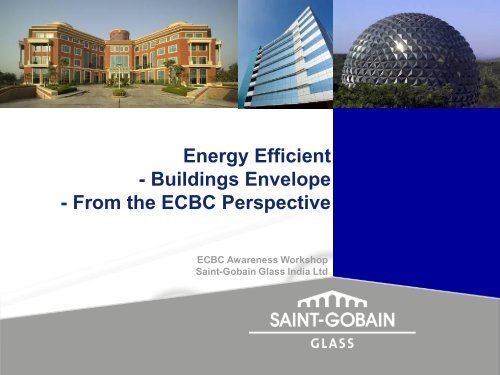
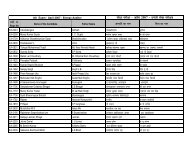
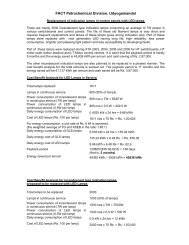
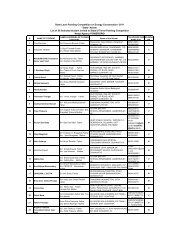
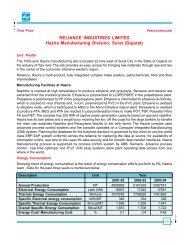

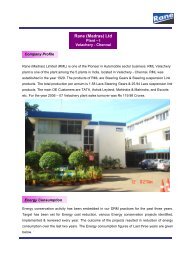
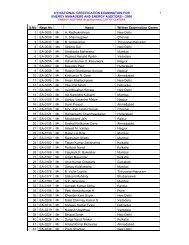
![Armstrong-Utility Soluitions [Compatibility Mode] - Energy Manager ...](https://img.yumpu.com/15315503/1/190x146/armstrong-utility-soluitions-compatibility-mode-energy-manager-.jpg?quality=85)
